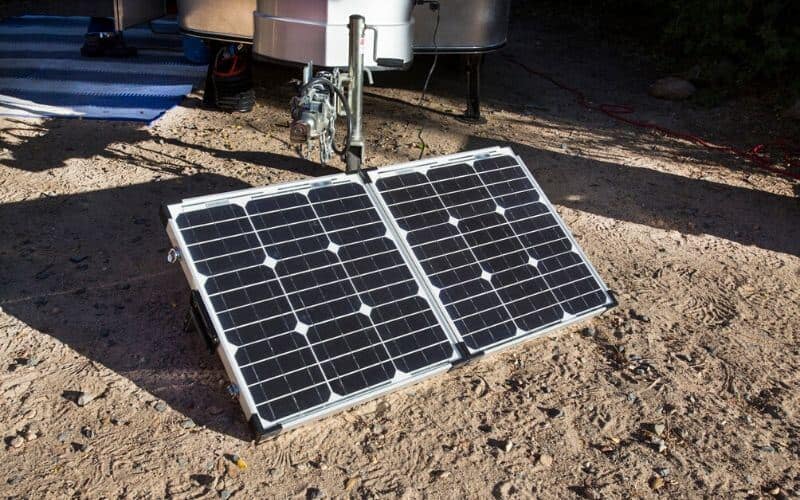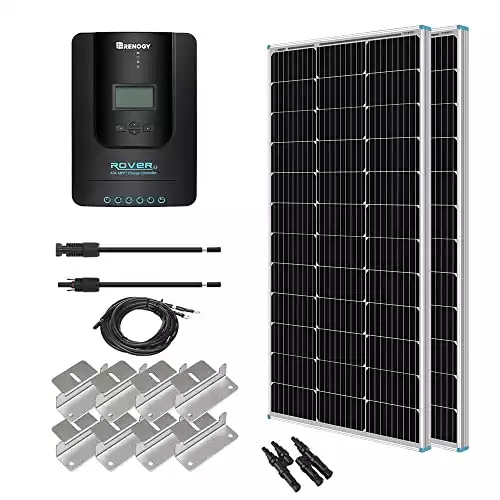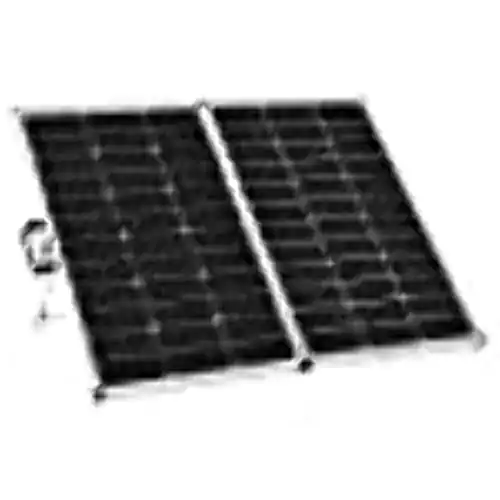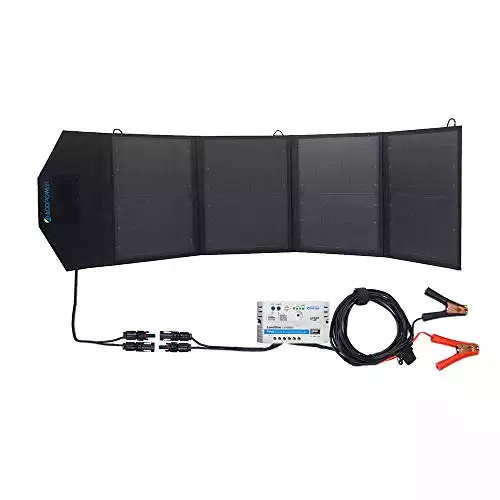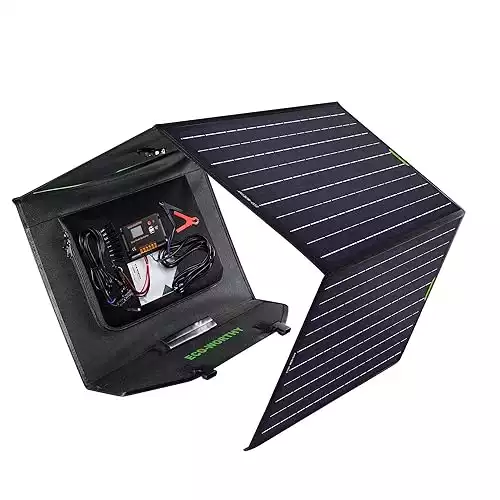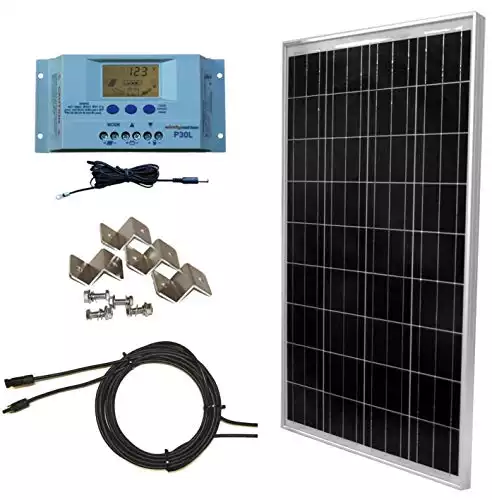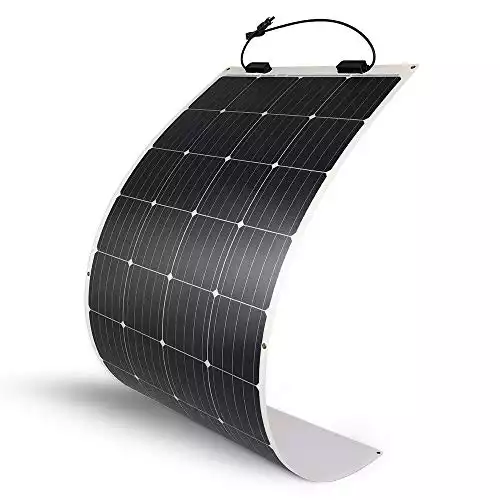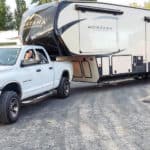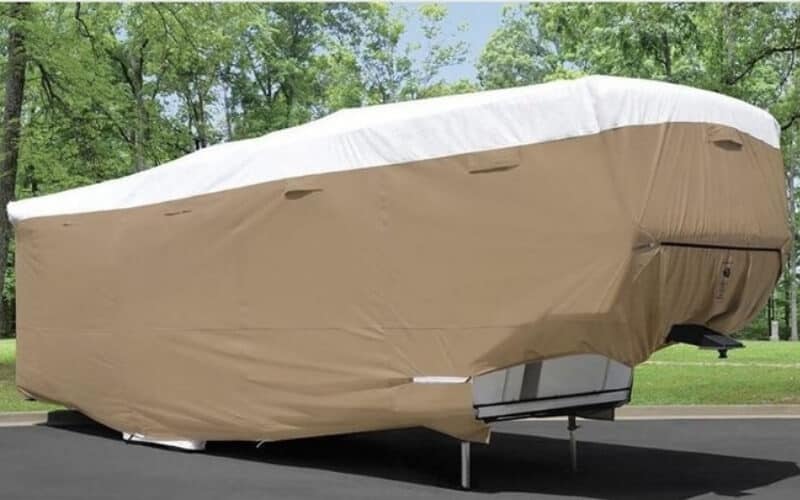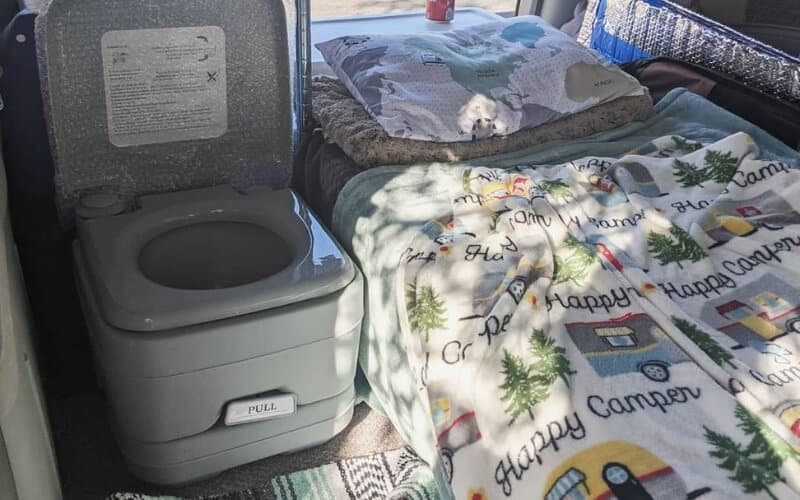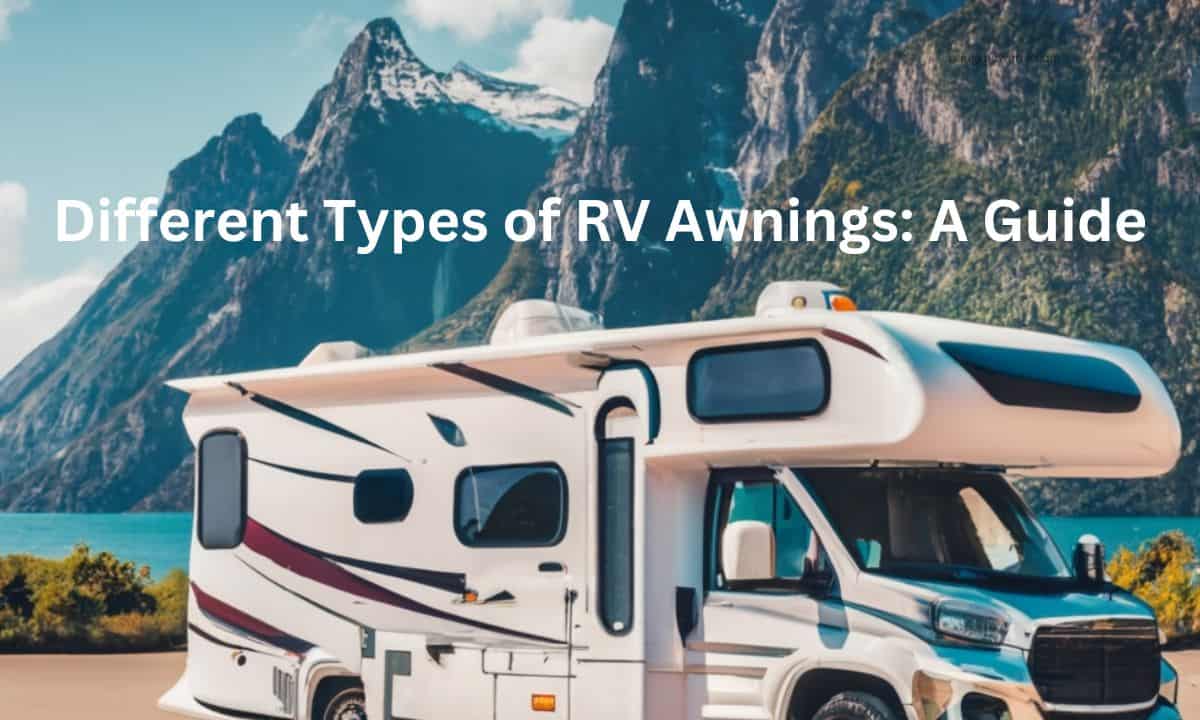Off-grid living is certainly trendy right now, but it’s more than just a passing fad. It’s an incredibly smart way to live and an RV is arguably one of the best ways to get off-the-grid safely and comfortably.
The main problem with off-grid RV living is having enough power without plugging into an electrical stand.
Even the best deep cycle marine battery won’t provide power to your RV forever. But that can change if you get portable solar panel kits for RV use.
Portable solar systems are super useful for recharging your RV batteries when dry camping because they’re much easier to set up than a permanent solar installation.
You’ll also be able to take them with you if you buy a new RV or move into an off-grid cabin and sell your RV. But there are a lot of RV solar panel kits out there to choose from.
Fortunately for you, we’ve researched the market and chosen seven of the best portable solar panels and kits for RV living.
And once you’ve checked out the panels themselves, be sure to consult our Buying Guide so you know how to choose the right solar panels for your situation.
7 Best Portable Solar Panel Kits For RVs
These are our seven choices for the best portable solar panel kits for RV use. We’ve reviewed each to provide pros and cons and a recommendation for which area they excel in. So let’s dive in!
1. Best Overall: Renogy 200 Watt 12 Volt Monocrystalline Solar Starter Kit
If you’re looking for a highly efficient portable RV solar panels that comes with all the essentials, the Renogy MPPT-Rover40 Solar Starter Kit is our best overall choice.
This is an extremely efficient system with monocrystalline panels that achieve an 18.4% efficiency and an MPPT charge controller with a peak efficiency of 97%.
While the system is rated for 200 watts, the 40A charge controller allows you to expand it up to 800 watts with additional panels.
The two panels that come with this kit perform very well even in low-lighting conditions and the system includes bypass diodes that minimize the power drop typically caused by shade.
As someone who’s dealt with the debilitating effects of rust on RV components, I personally love that the aluminum frames providing support for the solar cells are corrosion-resistant.
In my mind, this signals a construction that’s going to last for years, even if you live in areas where salty air speeds up the metal corrosion process.
This RV solar kit actually comes with two 100 watt solar panels. They weigh 16.5 pounds each and have dimensions of 42.2” by 19.6” by 1.38”.
These RV solar panels are rated for a maximum system voltage of 600 volts DC and they are backed by the manufacturer’s 25-year transferable power output warranty and 5-year material and workmanship warranty.
The rv solar kit also includes the 40A MPPT charge controller, which weighs just under 4.5 pounds and offers a maximum battery voltage of 32 volts.
This kit also comes with eight-foot charging cables, mounting Z brackets, and an adaptor kit set.
The charge controller that comes with this kit is also equipped with a number of protections that make the system, as a whole, extremely safe.
This includes protections against overcharging, overload, short-circuit, and reverse polarity.
And finally, the panels come with pre-drilled holes on the back to simplify the mounting process.
Things We Like
Things We Don’t Like
2. With Charge Controller: Zamp solar Legacy Series USP1002 solar panel for RV
If you’re looking for a single RV portable solar panel that’s compact and easy to deploy, the Zamp Solar Legacy Series monocrystalline panel is an excellent choice.
This solar panel is also a great choice for smaller RVs or camper vans, as it includes just a single 140-watt panel but it comes with everything you need for quick setup.
The portable solar panels for camping itself has a 5-stage, 10-amp charge controller built right into it. This controller helps to protect your battery from overcharging and the panel is best suited to RVs with 12-volt batteries.
The controller is also equipped with a large digital display that helps you track your power usage and the efficiency of the panel.
When you need to make a move to a new spot, the entire paddle folds up and packs into a padded carrying case.
So this solar setup is ideal for ground installation, but it can also be securely placed on top of a small camper van as long as no high winds are expected.
The panel itself weighs 32.75 pounds and the entire package has closed dimensions of 32.4” by 21.5” by 3.1”.
The solar cells in the panel are made of high-grade monocrystalline and they’re treated with anti-reflective coating.
This treatment process happens by hand at Zamp’s headquarters in Bend, Oregon and it helps to maximize the panel’s light absorption.
All in all, this panel is capable of generating a total of 7.8 amps and has extendable legs that help you set it up at an optimal angle for maximum sun exposure.
The entire rv solar kit also comes with alligator clips and an integrated SAE plug if your RV boasts a sidewall solar port.
Some notable RV brands that include Zamp Solar ready ports include Winnebago, Forest River, Keystone, and Airstream.
But it should be noted that this is not a complete list of all RVs that are compatible with a Zamp solar port.
Things We Like
Things We Don’t Like
3. Best With Portable Suitcase: ACOPOWER 120W 12V Portable Solar Suitcase For RV
The ACOPOWER portable RV solar suitcase is the ideal setup for cab-over campers and camper vans because it’s one of the most portable and compact solar kits on the market.
When packed up, the entire kit weighs less than nine pounds and the panels themselves pack into a suitcase-style case that makes them super easy to move around.
The monocrystalline solar cells used in this panel are made by SUNPOWER, which is the highest conversion efficiency module provider in the world.
That’s why these panels can achieve a maximum conversion efficiency of up to 25%.
This kit works best with 12-volt RV batteries, but it comes with alligator clips to connect to your battery with ease and immediately begin charging.
As someone who dreams about having a lightweight solar setup for an on-the-go lifestyle, I love the fact that this is arguably the easiest kit on our list to setup.
It can be ready to go in about one minute and it includes stands that velcro to the back of the panels to help you position them with optimal sun exposure.
With dimensions of 22” by 17.5” by 1.2”, this is also one of the most compact kits on the market.
When you’re ready to move, the panels fold together and include a handle for easy carrying.
There’s also a pocket on the panel for holding its accessories, which includes removable MC4 connector cables, alligator clamps, and the user manual.
This RV solar kit also comes with a 10-amp LCD charge controller that allows you to monitor your power usage while it’s set up.
The fabric and cell surface of the RV solar suitcase is also weatherproof for more durability when used outdoors.
And finally, the wiring on the back of the panels comes pre-installed, so this is an extremely user-friendly setup even if you don’t have a lot of electrical or solar experience.
Things We Like
Things We Don’t Like
4. Best For Solar Generator: ECO-WORTHY 120W Foldable Solar Panel Charger Kit
If you need a RV solar power unit that’s compatible with a portable solar generator to help you complete an off-grid power station, then the ECO-WORTHY Solar Panel Kit is your best option.
This kit is compatible with many different portable solar generators, including those from brands like Prymax, Rockpals, Suaoki, Webetop, and ENKEEO.
The cables are pre-installed onto the panels to make setting them up much quicker and easier.
The only drawback to this setup is that the cables are less than 10 feet long, so you’ll need to set the panel close enough to your RV battery to make a solid connection if you choose this route.
This may restrict your ability to place your panels where they can receive optimal sun exposure, which is why they’re made to power a portable solar generator rather than hooking directly into an RV battery.
The generator can then be used to provide additional power to your RV, but this will require an additional step.
The main benefit of this setup, however, is that you can use the generator for much more than simply powering your RV.
And you can also use it as a way to minimize the use of your RV batteries altogether.
These panels come with two five-volt USB ports that allow you to plug smaller electronics into them directly.
This means you can charge phones, laptops, and other small devices without worrying about draining your RV battery.
The ECO-WORTHY 120 watt panel uses high-efficiency solar cells for better energy capture and transfer.
They’re capable of converting between 21.5 and 23.5 percent of solar rays into usable energy for your RV.
The cells themselves are made of monocrystalline silicon and the panels fold into dimensions of 21.5” by 14.6” by 2.5” for easier storage when you’re in transit.
Things We Like
Things We Don’t Like
5. Best LCD Control Screen: WindyNation 100 Watt Solar Panel for 12 Volt Battery Charging
If you’re searching for portable RV solar panels that come with an LCD display that allows you to better track usage information, the WindyNation Solar Panel Kit is exactly what you’re looking for.
The control screen that comes with this kit will show you amperage, voltage, temperature, and other critical information.
The LCD Control Screen also makes it easier to change your system mode and settings using the convenient UP and DOWN arrows.
This system also comes with protections against overcharging, overload, and short-circuiting.
And it’s one of the few kits that include battery temperature sensors to help you ensure your battery isn’t overheating when connected to the panel.
While you can use the WindyNation panel on the ground, it’s best application is actually as a roof-mounted panel.
It comes with anodized aluminum Z-brackets and four sets of stainless steel fasteners to help you complete the installation.
The components are all corrosion-resistant to last longer and stand up to the weather that you know they’ll see once you’ve installed them on your roof.
The charge controller that comes with this kit is capable of handling additional panels, so you can expand this system if you desire.
As is, it’s rated to provide up to 400 watt-hours (33 amp hours) of charge per day if you’re able to keep the panels in direct sunlight.
But the panel that comes with this kit also performs well in low-light conditions.
This kit has a high operating temperature and it comes with one pair of solar connectors.
These connectors provide a waterproof connection between the solar extension cable and the solar connectors that come pre-attached to the back of the panel.
Also, this kit comes with 40 feet of solar extension cable, which makes it easier to choose a roof location and still be able to connect to your RV’s 12-volt battery.
Things We Like
Things We Don’t Like
6. Best Budget-Friendly Panel: ALLPOWERS Bendable SunPower Solar Panel For RV
If you want to install a solar panel to help trickle charge your RV battery but you’re on a tight budget, the ALLPOWERS Bendable Solar Cell is the most budget-friendly solar panel choice on our list for charging your rv battery
It’s also extremely lightweight and durable. The panel itself is water-resistant and the flexible material it’s made from makes it more durable than most traditional aluminum-framed panels.
This panel also provides great efficiency with a conversion rating of up to 23 percent.
This is an impressive efficiency given the panel’s size and considering the fact that many larger panels have an efficiency rating between 17 and 19 percent.
This RV solar panel kit supplies efficient energy to a 12-volt RV battery. It also has great applications on curved roofs because of its flexibility.
The panel itself can be curved to an arc of up to 30-degrees if you wish to install it directly to your RV roof.
It’s also frameless and comes with four metal-reinforced mounting holes at the corners for easier installation.
The flexibility of this panel also makes it great for smaller RVs and camper vans that don’t have a ton of roof space to work with.
You’ll be able to flex the panel to fit your desired location and its flat dimensions measure 22.05” by 21.26” by .01” (i.e. it’s really thin!!).
The junction box that’s attached to the panel includes protections against short circuits and surges, but our research unfortunately did turn up some instances in which the junction box became detached from the panel after just a few months of use.
Nevertheless, it boasts a working current of 2.7 amps and it can handle a maximum system voltage up to 1000 volts without suffering damage.
Things We Like
Things We Don’t Like
7. Best Versatility: Renogy 175 Watt Monocrystalline 12 Volt solar panel
The Renogy Flexible Monocrystalline Solar Panel is easily the most versatile RV panel in terms of installation.
You’ll be able to make this panel work on RVs that other panels simply aren’t compatible with because of its flexibility.
The panel can be flexed up to 248 degrees to be mounted on curved surfaces, Airstream roofs, and any other desired location.
For a panel with dimensions of just 59.2” by 26.5” by 0.08”, it can generate an impressive 175 watts and can also be linked with other Renogy panels to provide additional power if needed.
It boasts an optimal operating current of 8.75 amps and weighs just 6.2 pounds.
And while we’re talking specifications, this panel has an operating temperature range from -40 degrees up to 185 degrees Fahrenheit (-40 to 85 degrees Celsius).
One reason why this panel can still work well at high temperatures is that the back sheet of the panel is finished with TPT material that serves to dissipate heat.
This material also makes the panel last longer because it isn’t subject to the degrading effects of excessive heat.
The aluminum frame around the solar cells also provides a corrosion-resistant finish to further increase the panel’s lifetime.
If you want to mount this panel to your RV roof more permanently, you’ll be able to use Renogy Z-brackets or tilt mounts to do so.
The panel itself comes with six pre-drilled and metal-reinforced mounting holes to make it easier to secure in place.
And once you do, you don’t have to be worried about severe weather causing damage to your panel and its components.
The junction box on this panel boasts an ingress protection rating of IP68 and it also comes with weather-resistant MC4 connector cables.
The entire panel is rated to withstand high winds up to 2400 pascals and snow loads up to 5400 pascals.
And you can also rest assured knowing that this product is backed by the manufacturer’s 25-year power output warranty and five-year material and workmanship warranty.
Things We Like
Things We Don’t Like
How To Find The Best RV Portable Solar Panel And Kits?
But how do you decide exactly which solar panel kit is correct for your RV? Well, it’s important to understand more about the different types of panels and how each works.
You’ll also want to know more about the specific features and specifications of these panels so you can more accurately compare them. We’ll cover all of that in this Buying Guide.
Types Of Portable Solar Panel
Portable solar panels can be separated into three basic categories. So let’s start by defining each and suggesting some advantages and disadvantages of these three solar panel types.
Monocrystalline Panels
Monocrystalline panels are the most recognizable type. They look like the familiar dark panels that most of us probably associate with solar energy capture. This type of panel is very efficient and achieves a high power output.
They also tend to be the most durable type and they are less sensitive to high temperatures than other panels.
Because of their high power output and durability, however, they’re generally the most expensive type of solar panel on the market today.
Polycrystalline Panels
Polycrystalline panels are blue in color and have a spotted or speckled appearance. This type of panel is more affordable than its monocrystalline counterpart, but they tend to be less efficient.
They’re also more sensitive to high temperatures, which causes them to have a shorter lifespan than other panels.
Thin-Film Solar Cells
Thin-film solar cells are arguably the most versatile type of solar panel. They are easier to produce and, therefore, more affordable than both monocrystalline and polycrystalline panels.
They also have the ability to withstand higher temperatures and they have the added benefit of being flexible.
This flexibility allows for more installation options and can be especially useful for the curved nature of many RV roofs.
However, the downside of these solar cells is that they tend to be larger and bulkier than crystalline panels. They also generally have a shorter lifespan.
How Much Solar Power Do You Need For My RV?
So how much power do you need your solar panels to generate? This is the solar energy question of the century, regardless of whether you’re talking about an RV installation or setting up solar panels for your entire home. But let’s focus on RV applications, of course!
Determining how much power you need your panels to generate depends on whether solar energy is going to be your primary energy source or simply a supplement.
If you only need a solar panel that can slowly trickle charge your RV battery for emergency backup, something as low as a 50 watt panel might be enough.
But if you plan to provide power directly to wall outlets and appliances using your solar panels, you might need multiple 200-watt panels.
But the problem with this idea is that you might end up running out of roof space very quickly if you decide to install a family of panels.
For reference, some large RV air conditioning units can require up to 3500 watts to get started and will require a continuous supply of 1500 watts to keep running.
The largest portable solar panels provide 200 watts, so (excuse us while we do a little math…) you’d need more than 17 solar panels to start an RV A/C unit of this size.
This is simply unrealistic for an RV with limited roof space. And it doesn’t even account for the fact that other smaller appliances may be running at the same time as your air conditioner.
There’s a reason why many RV generators can supply upwards of 30 amps. Portable solar panels, on the other hand, rarely supply more than 10 amps.
So you need to be careful with determining your power needs when deciding on the optimal solar panel installation for your RV.
The best path is to use your solar panels to charge smaller electronics and recharge your onboard 12-volt batteries.
Of course, a larger panel will be able to recharge your battery more quickly and supply more power for charging small electronics.
Ease of Use (include Portability)
All of these solar panels systems will require some basic electrical knowledge to install properly.
That being said, some are much easier than others and you should always look for a solar panel kit that comes with clear instructions.
A great way to check this is to look at consumer reviews to see what people are saying about the panel’s installation process.
Because these are portable solar panels, after all, we’re going out on a limb here in believing that you’re interested in them because you want to be able to move them around.
As you went through the reviews above, you probably noticed that some seemed more portable than others.
Make sure you consider how easy it will be to relocate your panels if that’s your intention.
Additionally, whether or not your panels will easily serve your purpose depends…well…on YOUR purpose.
If you intend to use solar panels to supply your RV’s daily power needs, for example, a kit that doesn’t include a transfer switch might not be so easy to use.
You’ll need to purchase the switch separately and then figure out how to install it safely.
This is just one example of a potential scenario in which a RV solar panel kit that sounded good upfront might not serve the purpose you had intended it for.
Make sure you know your power needs and how exactly you plan on using your panels so that you can choose a product that will be easy for you to use.
Because electricity is involved, we do recommend hiring an expert if you feel at all uncomfortable with the installation process for your solar panels.
It’s better to be safe than sorry on this front and it’s always good to hire someone if you’re not familiar with the difference between positive and negative terminals, how to connect fuses, where your inverter should tie in, and other important nuances of setting up a solar installation.
Durability
The good news is that portable solar panels generally tend to be more durable than roof-mounted panels.
This is because they’re specifically designed to be moved around frequently and connected and disconnected often.
But different portable panels are more or less durable depending on the materials used in their construction.
When you’re assessing the durability of a particular panel or solar kit, make sure to pay attention to the quality of all components and not just the panels themselves.
This includes the cables, frame (if applicable), clamps, connectors, and other accessories.
Durability in solar panels is just as important as with any other external RV accessory, such as roof antennas and tire pressure monitoring systems (TPMS).
Optimal Operating Temperature
Unless you’ve installed a transfer switch that allows your solar panels to supply direct power to your RV’s outlets and appliances, your solar panel’s ability to capture energy is only as good as your battery’s ability to store that energy. And battery capacity can be directly impacted by the air temperature.
Generally speaking, RV batteries don’t like too much heat. In fact, a battery’s life will be cut in half every time the temperature rises by 15 degrees Fahrenheit.
Interestingly though, storage capacity will also increase by 10 percent with this same temperature increase.
Conversely, colder temperatures actually increase a battery’s lifespan. But for every 15-degree temperature decrease (still Fahrenheit), a battery’s storage capacity will be reduced by 10 percent.
When your battery has less storage capacity, it boils down to less energy to use between solar charges.
So this is important when considering how quickly a given solar panel can bring your batteries back to full charge.
Solar panels themselves also have optimal operating temperatures. While most are rated to operate efficiently at most temperatures other than the absolute most extremes, it’s always good to check the rating to make sure it will work well in the temperature range where you spend most of your time in your RV.
Solar Charge Stages
Many of the panels we’ve detailed come with charge controllers. When panels are in the charging process and the charge controller is functioning properly, there are three general stages they go through.
These three stages are called bulk charge, absorption charge, and float charge, respectively.
Bulk Charge
Bulk charge refers to the stage when 100% of the available power from the panels is used to charge your RV battery (or batteries).
The bulk charging stage will generally continue until the absorption voltage (typically 14.4 to 14.6 volts) is reached.
Absorption Charge
The absorption charge stage begins once the set absorption voltage is reached. At this point, your RV battery is usually somewhere near 85 percent of its full charge capacity.
In order to avoid overcharging, the controller will now work to maintain that set absorption voltage for a given period of time.
This is usually one or two hours, but a controller’s absorption voltage and time period are usually pre-programmed by the manufacturer. Some controllers also allow you to customize these settings.
Float Charge
The float charge stage begins after the absorption charge phase is complete (i.e. the programmed time period in the controller passes).
Your batteries will be close to fully charged at this point, so your controller will actually bump down the battery charge voltage to somewhere between 13.2 and 13.7 volts. Again, the exact number will depend on the manufacturer.
It will then hold this lower voltage for as long as the sunlight is still hitting your solar panels.
By holding this lower voltage, it ensures that battery acid isn’t boiled off and batteries aren’t overcharged.
Mounting Options
Fortunately, most solar panels come with all of the brackets and adapters you’ll need to complete the installation process.
But if this isn’t the case, you should know what else you’ll need to mount your panels before you purchase them.
Of course, if you simply plan to set your portable panels on the ground during the day, mounting won’t be an issue.
But you still need to know what your mounting options are before purchasing a solar panel kit so that you can be sure you have an option that’s compatible with your RV setup.
Best RV Portable Solar Panels Compared: So, Which Is Best For You?
The Renogy MPPT-Rover40 Solar Starter Kit is our pick for the best overall portable solar panels for RV use because this rv solar kit is specifically designed to make it easy for those with relatively minimal solar experience.
It’s also rated to supply the highest wattage of any panel on our list and the controller it comes with allows you to expand the system for even more capacity.
But if you’re looking for a second option, we highly recommend checking out the Renogy Flexible Monocrystalline Solar Panel.
We love the versatility of this panel and we think you’ll appreciate the fact that it comes with excellent weatherproof features.
It’s one of the best flexible solar panel options for installing on curved roofs or other tricky locations.
Frequently Asked Questions
Electrical circuits are quite simple if you have a basic understanding of them. But they can certainly appear complex if you’re new to them.
So let’s bulk up your proverbial ‘electrical tool kit’ by answering several important questions about solar panels and their use.
How much power do I need?
The answer to this question will largely depend on whether you want solar panels to simply top off your battery charge or you’re looking for a larger system that can supply your RV’s daily power needs.
Most individuals panels top out at 200 watts, but you should determine your specific power needs before selecting a panel.
Where should I install my panels?
Portable panels are specifically designed to be installed or set up wherever it is most convenient for optimal sun exposure.
However, the roof of your RV is the most common location to install this type of panel.
Of course, that will require that you park your rig in an optimal fashion for direct sunlight to hit your roof for the majority of the day.
It’s important to understand how many hours of direct sunlight your panels need in order to function at optimal capacity, as this will help you make a more informed installation choice.
If you choose to simply set up your panels somewhere on the side of your rig, you’ll need to be sure you have enough cable to run from the panels to your RV battery.
Note here that a longer cable will result in less power being transmitted from the panels to your battery.
So it’s a good idea to place the panels as close to your battery as possible if you wish to achieve maximum panel output.
Do I need more than just the panels to complete my setup?
The short answer here is yes. At the very least, you’ll need cables to connect your panels to your battery.
And if you don’t have a battery that’s compatible with the panels you want to buy, you may need to make a new investment in that department as well.
The need for any additional purchases will, again, depend on how you plan to set up and use your panel arrangement.
If you plan to purchase a significant number of panels to capture additional wattage, you may need to purchase an additional deep cycle marine battery to increase your energy storage capacity.
This may also require the purchase of a solar charge controller, which will prevent overcharging of your batteries.
This is necessary because some panels produce a much higher voltage than batteries are rated to handle.
And if you plan to use your solar panels to supply your RV’s daily power needs, you’ll probably also need an inverter and/or a transfer switch.
The purpose of an inverter is to convert direct current (DC) to alternating current (AC).
The batteries that your panel’s charge will typically produce DC, but if you want to have complete off-grid power functionality in your RV, you’ll need an inverter that can supply AC to your outlets and other appliances that require it.
A transfer switch will allow your panels to supply power directly to outlets in your RV without first charging your batteries.
This is useful for using solar to provide for your daily power needs, but it may require a bit more electrical wiring installation upfront.
Should I choose portable or roof-mounted panels?
This really depends on how much power you need. It’s important to note that most portable solar panels these days max out at about 200 watts.
So you might need quite a few of them if you plan on powering your entire 40-foot RV using solar energy.
If this is the case, you might consider installing a few roof-mounted panels and then having another portable panel at your disposal for added solar collection and adaptability to sun conditions.
But if you’re trying to use solar energy for a small camper van, for example, you probably don’t have enough roof space for larger roof-mounted panels.
So you’ll need the type of portable panels that can be installed and removed more regularly depending on your immediate needs.
So let’s try to sum this up more succinctly. If you’re a full-time RVer who wants to power your entire RV with solar and you have a fairly large rig, we’d recommend going with roof-mounted panels.
But if you have a smaller rig and you need more versatility with how your panels are set up, portable solar panels are the best option.
Is it important what type of batteries are already in my RV?
Yes! You’ll need to know the voltage and amp-hour ratings for the batteries currently in your RV in order to select compatible solar panels.
Most RV batteries are either 12-volt or 6-volt batteries, but the amp-hour rating of each battery tends to have more variation.
When you’re assessing the storage capacity of your existing RV batteries, it’s important to realize that the amp-hour rating in the battery’s specifications is tested at a certain temperature, which is usually about 77 degrees Fahrenheit.
That amp-hour rating will change depending on the temperature of the outside air, which we covered in more depth in the Optimal Operating Temperature section above.
But it’s worth reiterating here that a battery’s capacity will be directly influenced by the temperature of the outside air. And now you also know why so many RVers chase warm weather!
Conclusion
Getting portable solar panels will allow you to camp in more remote areas and stay off-the-grid for longer periods of time.
They’re obviously best for places that get significant direct sunlight for multiple hours every day, but the great part about using them for an RV is that you can strategically position your rig so your panels receive optimal sun exposure.
As someone who has spent almost a full year living on-the-grid in an RV, I can tell you that making an initial investment into solar panels would’ve certainly reduced my annual electrical costs.
So if you have long-term plans for your RV, you should definitely make the up-front investment into quality portable solar panels!

